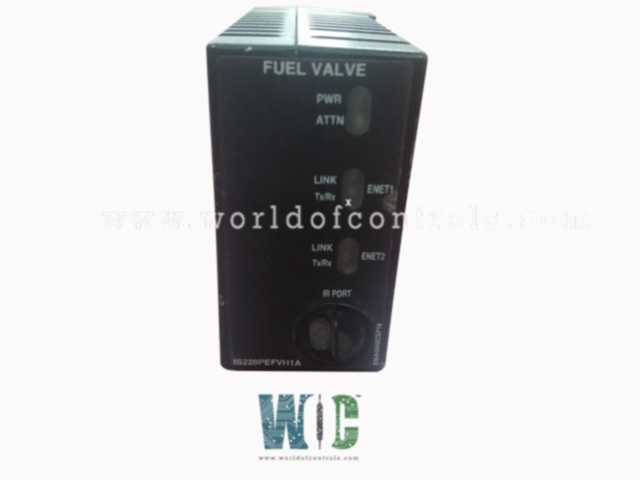
World Of Controls understands the criticality of your requirement and works towards reducing the lead time as much as possible.
IS220PEFVH1A, REV D - Electric Fuel Valve Bridge I/O Module is available in stock which ships the same day.
IS220PEFVH1A, REV D - Electric Fuel Valve Bridge I/O Module comes in UNUSED as well as REBUILT condition.
To avail our best deals for IS220PEFVH1A, REV D - Electric Fuel Valve Bridge I/O Module, contact us and we will get back to you within 24 hours.
SPECIFICATIONS:
Part Number: IS220PEFVH1A, REV D
Manufacturer: General Electric
Series: Mark VIe
Product Type: Electric Fuel Valve Bridge I/O Module
Transmit Time: 100 times /sec
Power supply voltage: 28 V DC
Fault Detection: Ethernet link is ok to/from DVP
Voltage Range: 14 to 32 V DC
Outputs: 24 V dc
Mounting: DIN-rail mounting
Technology: Surface mount
Operating temperature: -30 to 65°C
Size: 8.26 cm high x 4.19 cm
Repair: 3-7 days
Availability: In Stock
Weight: 2 lbs
Country of Origin: United States
Manual: GEH-6721G
FUNCTIONAL DESCRIPTION:
IS220PEFVH1A, REV D is an Electric Fuel Valve Bridge I/O Module manufactured and designed by General Electric as part of the Mark VIe Series used in GE Distributed Control Systems. The Electric Fuel Valve Bridge I/O Module serves as an Ethernet gateway between the Mark VIe I/O Ethernet network and the electric fuel valve interface, known as the Digital Valve Positioner (DVP), manufactured by Woodward Controls. This module communicates via Ethernet Global Data (EGD). It features a processor board common to all Mark VIe I/O packs. One of its dual RJ45 Ethernet ports connects to the I/O Ethernet network, while the other connects directly to the DVP. Additionally, a 3-pin connector is used to supply power to the module.
COMPATIBILITY:
In this configuration, the Electric Fuel Valve Terminal Board (TEFVH1A) is used solely to mount the PEFV. The board’s connections are limited to electronic identification purposes, with no additional wiring used. Diagnostic indicators are available via LEDs on the PEFV, and local serial diagnostics can be accessed through an infrared port. The control mode indicates how many I/O packs are involved in the signal path.
INSTALLATION:
To implement triple modular redundancy (TMR), plug three PEFVs directly into the terminal board connectors. Secure each pack using the threaded inserts next to the Ethernet ports, which attach to a mounting bracket designed for the specific terminal board. Ensure the bracket is properly aligned to avoid applying lateral force to the DC-37 pin connector between the pack and the terminal board—this alignment is a one-time setup.
OPERATION:
The processor board interfaces with an acquisition board tailored to the specific I/O pack function. When input power is applied, a soft-start circuit gradually increases the voltage to the processor. This triggers a sequence that powers up local supplies and releases the processor from reset. The processor then runs self-tests and loads application-specific code from flash memory. It verifies compatibility by checking board ID data to ensure proper alignment between the application code, acquisition board, and terminal board. If matched correctly, the processor initiates Ethernet communication by requesting a network address via DHCP, using the unique ID from the terminal board. Once Ethernet is established, the processor configures internal logic, launches the application, and activates the acquisition board.
WOC has the largest stock of GE Distributed Control Systems OEM Replacement Parts. We can also repair your faulty boards and supply unused and rebuilt boards backed up with a warranty. Our team of experts is available around the clock to support your OEM needs. Our team of experts at WOC is happy to assist you with any of your automation requirements. For pricing and availability on parts and repairs, kindly contact our team by phone or email.
What is the primary function of the PEFV module?
The Electric Fuel Valve Bridge I/O Module (PEFV) functions as an Ethernet gateway between the Mark VIe I/O Ethernet network and the Digital Valve Positioner (DVP), which is used for controlling electric fuel valves. This interface enables seamless communication and command execution over the plant network using standard industrial protocols.
How many Ethernet ports are available, and how are they used?
The PEFV features two RJ45 Ethernet ports. One port connects to the I/O Ethernet network within the Mark VIe system, while the second connects directly to the Woodward DVP. These ports allow for flexible configuration and provide communication paths for both upstream and downstream data exchange.
What happens if Ethernet connections are modified during operation?
The PEFV must be rebooted if Ethernet connections are changed after startup. Although either Ethernet port can be used, standard practice is to connect ENET1 to the I/O Ethernet network for consistent configuration and management.